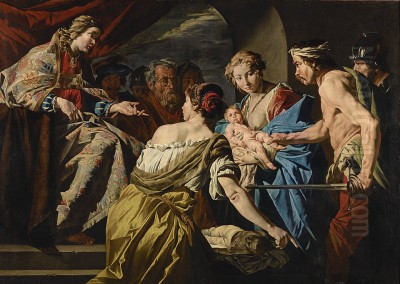
Matthias Stomer, sometimes known as Matthias Stom, stands as a fascinating figure in the landscape of 17th-century European art. A painter originating from the Netherlands during its Golden Age, he spent the vast majority of his productive career under the Italian sun. He became a prominent exponent of the Caravaggesque style, adapting the dramatic chiaroscuro and intense realism pioneered by Michelangelo Merisi da Caravaggio to his own distinct artistic vision. Though details of his life remain somewhat fragmented, his powerful body of work, primarily focused on biblical narratives, secures his place as a significant bridge between Northern European sensibilities and the revolutionary trends of the Italian Baroque.
Origins and Early Influences
The precise details of Matthias Stomer's birth and early training are not definitively documented, a common challenge when studying artists of this period. However, art historical consensus places his birth around the year 1600. His place of origin is generally believed to be Amersfoort, a town near Utrecht in the Netherlands. This geographical connection is crucial, as Utrecht was a major center for the reception and adaptation of Caravaggio's style in the North.
The "Utrecht Caravaggisti," a group of Dutch painters who had travelled to Rome in the early 17th century and fallen under the spell of Caravaggio's revolutionary art, returned to their home city filled with new ideas. Artists like Gerard van Honthorst, Hendrick ter Brugghen, and Dirck van Baburen brought back the dramatic use of light and shadow (chiaroscuro), the preference for depicting ordinary people in religious scenes, and an overall sense of heightened realism. It is highly probable that the young Stomer was exposed to their work, absorbing the core tenets of this imported Italian style even before setting foot in Italy himself.
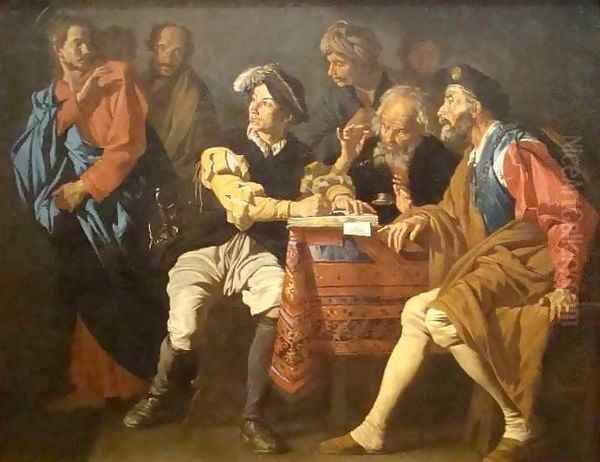
Some sources suggest a connection, possibly as a pupil or workshop assistant, to Gerard van Honthorst around the 1620s. Van Honthorst, known as "Gherardo delle Notti" (Gerard of the Night Scenes) in Italy for his mastery of candlelit compositions, would have been a natural mentor. Stomer's own later proficiency in depicting nocturnal scenes illuminated by artificial light sources certainly points towards an affinity with, if not direct tutelage under, Van Honthorst. His early formation likely also included familiarity with the works of earlier masters and the dynamic, pre-classical style of the Flemish giant, Peter Paul Rubens.
The Journey South: Rome
Like many Northern artists seeking to complete their education and find patronage, Stomer eventually travelled to Italy. The first documented evidence places him in Rome in 1630. A census record from that year lists a "Mattheo Stom, fiamengo pittore, di anni 30" (Matthias Stom, Flemish painter, aged 30), living in the Strada dell'Olmo. The term "fiamengo" (Flemish) was often used loosely by Italians to refer to people from the Low Countries in general, encompassing both Flanders and the Dutch Republic. This record confirms his presence in the artistic heart of Italy and provides a key anchor for his birth year (around 1600).
Rome in 1630 was still reverberating with the impact of Caravaggio, who had died two decades earlier. Although the initial shockwaves had subsided, his influence remained potent, propagated by both Italian followers like Orazio Gentileschi, Artemisia Gentileschi, and Bartolomeo Manfredi, and by the continuous influx of foreign artists drawn to his style. Stomer would have encountered a vibrant artistic community where Caravaggism coexisted with the more classicizing trends of the Bolognese school (led by Annibale Carracci and his followers like Domenichino and Guido Reni) and the burgeoning High Baroque represented by figures like Gian Lorenzo Bernini and Pietro da Cortona.
During his Roman period, Stomer undoubtedly refined his technique, absorbing the lessons of Caravaggio directly from the source and interacting with other artists. It is highly likely he encountered the work of Jusepe de Ribera, a Spanish painter deeply influenced by Caravaggio who had been active in Rome before settling in Naples. Ribera's powerful, often gritty realism and dramatic intensity would resonate strongly in Stomer's later work. While in Rome, Stomer began producing works that clearly showed his commitment to the Caravaggesque idiom, focusing on strong contrasts of light and dark and emotionally charged biblical scenes.
Naples: A Flourishing Career
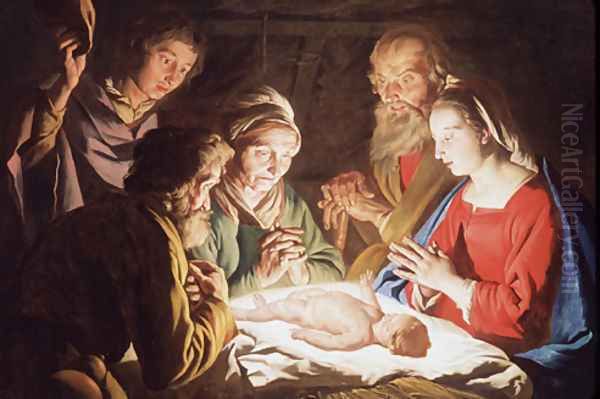
Stomer did not remain in Rome indefinitely. By approximately 1633, he had moved south to Naples. Naples, then under Spanish rule, was a bustling metropolis and a major artistic center in its own right. It had its own strong tradition of Caravaggism, significantly shaped by Caravaggio's own stays in the city and further developed by local artists and influential figures like Ribera, who had made Naples his permanent home by this time.
The Neapolitan art scene offered fertile ground for Stomer. The demand for powerful religious imagery was high, fueled by the Counter-Reformation and numerous church commissions and private patrons. Stomer's style, with its dramatic lighting and intense emotional focus, fit well within the prevailing tastes. He seems to have found considerable success in Naples, establishing himself as a respected painter.
His time in Naples saw the consolidation of his mature style. He continued to explore biblical themes, often depicting nocturnal scenes or moments of dramatic revelation perfectly suited to his mastery of chiaroscuro. The influence of Ribera is often noted in the works from this period, seen in the robust, earthy quality of his figures and the unsparing realism. However, Stomer maintained his own distinct voice, often favouring warmer tones and a slightly softer modelling compared to the sometimes harsher light of Ribera or the starkness of early Caravaggio. Some art historians also suggest a possible influence from Anthony van Dyck, who visited the region, perhaps visible in a certain refinement or richness in some Neapolitan-period works.
Sicilian Years and Later Life
After a productive period in Naples, Stomer moved further south to Sicily, likely around 1640 or shortly thereafter. He is documented in Palermo and seems to have spent a significant portion of the last decade or so of his known activity on the island. Sicily, too, had felt the impact of Caravaggio (who had worked there briefly) and possessed its own local artistic traditions.
In Sicily, Stomer continued to receive commissions, producing altarpieces and other religious works for churches and private collections. His presence was significant for the local art scene; he is considered one of the most important painters working in Sicily during this period. His powerful Caravaggesque style left a notable mark on Sicilian painters, influencing figures like Pietro Novelli, the leading Sicilian painter of the era. Works created during his Sicilian phase maintain the core characteristics of his style but sometimes show adaptations to local tastes or perhaps a further evolution in his handling of light and colour.
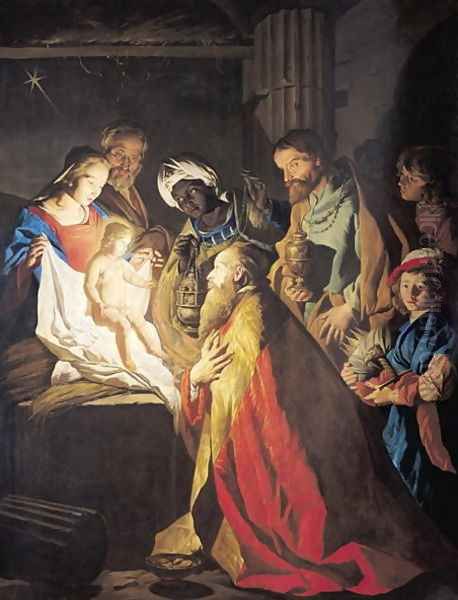
The exact circumstances and date of Matthias Stomer's death are unknown. There are no records confirming his activities beyond the early 1650s. It is generally presumed that he died sometime after 1652, possibly in Sicily, or perhaps after returning to mainland Italy. The lack of documentation leaves the final chapter of his life shrouded in mystery.
Artistic Style and Technique
Matthias Stomer's art is fundamentally defined by his adherence to the principles of Caravaggism. His most striking characteristic is his masterful use of chiaroscuro – the dramatic interplay of light and shadow. He often employed tenebrism, where figures emerge from a dark, undefined background, intensely illuminated by a single, often unseen or localized, light source. This creates a sense of immediacy, drama, and psychological intensity.
Unlike some Caravaggisti who favoured broad daylight scenes, Stomer showed a particular predilection for nocturnal settings or interiors lit by artificial means, such as candles, torches, or lamps. This allowed him to explore the subtle effects of light on surfaces, textures, and human expressions, creating intimate and often mysterious atmospheres. This affinity connects him stylistically to Utrecht painters like Van Honthorst but Stomer often achieved a greater sense of raw emotion and less polished refinement.
His figures are typically robust and realistic, often depicted with rugged features and dressed in contemporary or non-idealized historical attire. He avoided the idealized beauty associated with Renaissance or classicizing Baroque art, preferring instead to capture the human condition with honesty and directness. This realism extended to the emotional content of his work; his figures express palpable feelings – awe, grief, concentration, cruelty – drawing the viewer into the narrative.
While deeply indebted to Caravaggio, Stomer developed his own variations. His palette could be richer and warmer than Caravaggio's, sometimes incorporating deep reds, ochres, and browns. His handling of paint could be quite vigorous, yet capable of rendering textures effectively. He focused predominantly on religious subjects, particularly Old and New Testament scenes, but treated them with a focus on human drama rather than purely divine transcendence.
Key Themes and Subject Matter
The overwhelming majority of Stomer's known oeuvre consists of religious paintings. He repeatedly explored narratives from both the Old and New Testaments, often choosing moments of intense emotion, moral conflict, or divine revelation. His preference was clearly for narrative scenes rather than single-figure devotional images, although he did produce powerful depictions of saints and apostles.
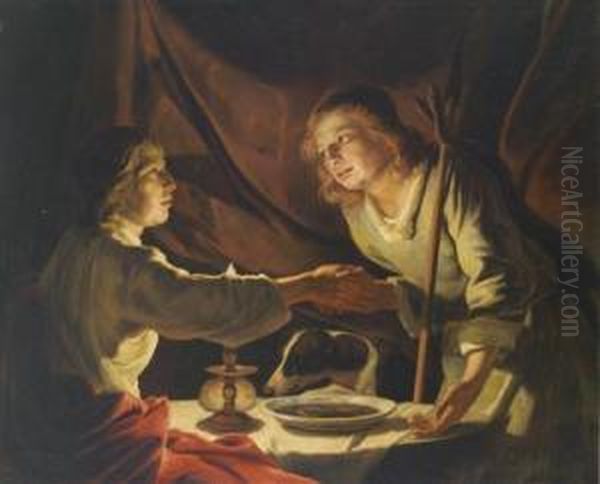
Old Testament subjects that appear frequently include the story of Abraham and Isaac, Lot and his Daughters, Samson and Delilah, and scenes from the lives of the patriarchs like Jacob and Esau. Esau Selling His Birthright is a theme he revisited, allowing him to explore themes of temptation, regret, and familial tension within a dramatically lit interior setting.
From the New Testament, Stomer depicted numerous scenes from the life of Christ. The Nativity and associated events, like The Adoration of the Shepherds or The Adoration of the Magi, were favourite subjects, perfectly suited for his signature nocturnal, candlelit treatments. He also painted scenes from Christ's ministry, such as The Calling of St. Matthew and Christ Among the Doctors, and dramatic episodes from the Passion narrative, including The Mocking of Christ, Christ before Pilate, and The Denial of St. Peter. These subjects allowed him to explore intense psychological states and dramatic confrontations.
Unlike some of his Dutch contemporaries, particularly those associated with genre painting, Stomer showed little interest in depicting scenes of everyday life, humorous tavern scenes, or purely decorative allegories. His focus remained steadfastly on significant human and divine dramas, rendered with gravity and emotional weight.
Representative Masterpieces
Several works stand out as exemplary of Stomer's style and thematic concerns:
The Calling of St. Matthew (c. 1629, Fine Arts Museums of San Francisco): An early example, likely from his Roman period, showcasing his debt to Caravaggio's famous rendition of the same subject. Stomer uses dramatic lighting to highlight the pivotal moment of Christ's summons and Matthew's astonished reaction amidst the mundane setting of the tax collector's office.
The Mocking of Christ: Stomer treated this theme multiple times. These paintings are powerful studies in cruelty and suffering, using stark chiaroscuro to focus attention on Christ's ordeal and the menacing figures surrounding him. The use of specific pigments, like Naples Yellow identified through scientific analysis in some versions, connects his work technically to the Southern Italian context.
The Adoration of the Shepherds: Another subject Stomer painted repeatedly. These works are often characterized by their tender intimacy, achieved through the warm glow of a lantern or candle illuminating the Holy Family and the humble shepherds, emphasizing the humanity of the divine event. The contrast between the brightly lit central figures and the surrounding darkness enhances the sense of wonder and reverence.
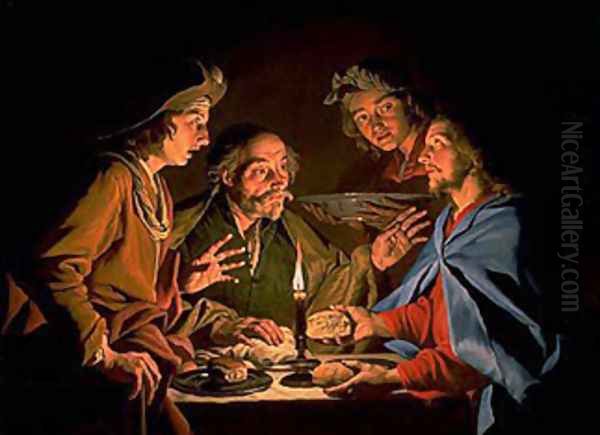
Esau Selling His Birthright: This scene allowed Stomer to explore complex human emotions within a domestic setting. The focused light typically highlights the transaction – the bowl of stew, the exchange between the brothers – emphasizing the gravity of Esau's impulsive decision.
Christ before Pilate: A composition filled with dramatic tension, contrasting the stoic figure of Christ with the agitated Pilate and surrounding soldiers. The play of light across faces and armour heightens the theatricality of the confrontation.
The Evangelists Mark and Luke with Their Attributes (c. 1650): A later work, demonstrating his continued mastery. The painting depicts the evangelists intensely focused, likely illuminated by candlelight, emphasizing their scholarly and spiritual concentration. This work achieved a significant price at auction in 2021, reflecting renewed appreciation for Stomer's art.
These examples illustrate Stomer's consistent engagement with dramatic narrative, his sophisticated handling of light and shadow, and his ability to convey profound human emotion within the framework of religious storytelling.
Influences and Contemporaries
Matthias Stomer operated within a rich network of artistic influences and interactions. The foundational influence was undoubtedly Michelangelo Merisi da Caravaggio. Stomer adopted Caravaggio's revolutionary use of chiaroscuro, his realism, his practice of using ordinary people as models for sacred figures, and his focus on the dramatic potential of biblical narratives.
Within the Northern Caravaggesque tradition, Gerard van Honthorst is the most frequently cited connection, particularly regarding the mastery of artificial light sources in night scenes. Other Utrecht Caravaggisti like Hendrick ter Brugghen and Dirck van Baburen formed the artistic environment of his youth.
During his time in Italy, Jusepe de Ribera exerted a significant influence, especially during Stomer's Neapolitan period. Ribera's robust realism, Spanish intensity, and established presence in Naples provided a powerful model. The broader Neapolitan scene included important artists like Massimo Stanzione and Bernardo Cavallino, whose work contributed to the city's vibrant artistic identity, though direct influence on Stomer is less documented than Ribera's.
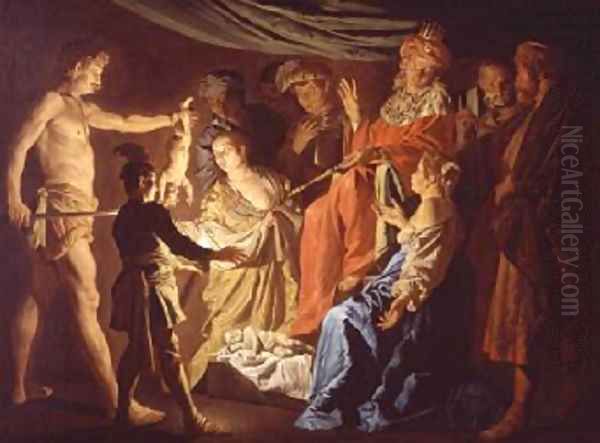
The towering figure of Peter Paul Rubens, though Flemish and not strictly a Caravaggisto, was an inescapable influence for many artists of the era. His dynamic compositions and rich colourism were known throughout Europe, and Stomer would certainly have been aware of his work, potentially absorbing aspects of its energy. Similarly, the brief presence of Anthony van Dyck in Southern Italy might have offered a model of elegant portraiture and slightly brighter palettes that could have subtly inflected Stomer's later Neapolitan or Sicilian works.
In Rome, Stomer would have been aware of Italian Caravaggisti like Orazio Gentileschi, Artemisia Gentileschi, and Bartolomeo Manfredi, as well as artists pursuing different paths, such as the classicist Guido Reni or the High Baroque master Gian Lorenzo Bernini. In Sicily, his work stands in dialogue with local painters, most notably Pietro Novelli. Even earlier masters known for dramatic lighting, like Adam Elsheimer, might be considered part of the broader artistic heritage Stomer drew upon.
Legacy and Collections
Matthias Stomer left behind a substantial body of work, estimated at over 200 paintings, though attribution can sometimes be complex. His immediate legacy was most strongly felt in Sicily, where his powerful style influenced local artists. However, as tastes shifted away from dramatic Caravaggism towards lighter, more decorative styles later in the 17th and 18th centuries, his name, like those of many other Caravaggisti, faded somewhat from prominence.
The 20th century saw a resurgence of interest in Baroque art and particularly in Caravaggio and his followers, leading to a re-evaluation of Stomer's contribution. He is now recognized as one of the most talented and distinctive Northern interpreters of the Caravaggesque style. His ability to fuse Northern European traditions with Italian innovations, particularly his mastery of light and psychological depth, is widely appreciated.
His works are now held in numerous major museums and private collections across Europe and North America. Notable holdings can be found in:
The Fine Arts Museums of San Francisco
The Musée de Grenoble
The National Gallery, London
The Museo del Prado, Madrid
The Kunsthistorisches Museum, Vienna
Various museums and churches in Naples and Sicily (e.g., Museo di Capodimonte, Naples; Palazzo Abatellis, Palermo)
The Kremer Collection
His paintings also appear on the art market, sometimes commanding high prices, as evidenced by the 2021 Christie's auction of The Evangelists Mark and Luke. The historical and artistic significance of his work, particularly pieces remaining in Italy, is recognized to the extent that the Italian government has placed restrictions on the export of certain paintings attributed to him.
Later Life and Unanswered Questions
Despite the increased recognition of his artistic importance, significant gaps remain in our knowledge of Matthias Stomer's life. The exact date and place of his death remain elusive, with documentation seemingly ceasing after the early 1650s. Whether he died in Sicily, returned to Naples, or perhaps even travelled elsewhere in Italy remains speculative.
The precise nature of his training in the Netherlands is also not fully confirmed, although the connection to the Utrecht Caravaggisti is stylistically undeniable. Even the spelling of his name varies in historical documents and art historical literature, appearing as both "Stom" and "Stomer." An old, unsubstantiated anecdote suggested "Stomer" derived from the Dutch word "stom" (meaning dumb or mute), implying a disability, but this is widely dismissed by modern scholarship; "Stom" was likely the name he used, possibly a standard variation or signature form.
These lingering questions do not diminish the power of his artistic achievement. They simply remind us of the challenges inherent in reconstructing the lives of artists from centuries past, particularly those who, like Stomer, moved between different countries and cultural contexts.
Conclusion: A Master of Light and Shadow
Matthias Stomer emerges from the historical record as a highly skilled and emotionally resonant painter who successfully navigated the complex artistic currents of the 17th century. Born in the North, he found his artistic voice in the South, becoming a leading figure among the foreign artists who embraced and adapted the revolutionary style of Caravaggio. His mastery of chiaroscuro, particularly in nocturnal and artificially lit scenes, allowed him to imbue traditional religious subjects with unprecedented drama and psychological depth.
Though overshadowed for a time by bigger names, Stomer's distinctive style – characterized by robust realism, intense emotion, and a profound understanding of the narrative power of light – has earned him a secure place in the history of Baroque art. His paintings continue to captivate viewers with their immediacy and their powerful exploration of the human condition within the grand theatre of biblical history. He remains a testament to the fruitful cross-cultural exchanges that defined European art during his era, a Northern light shining brightly within the Italian Baroque.